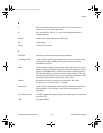
Glossary
©
National Instruments Corporation G-13 PCI-4451/4452 User Manual
nonreferenced signal
sources
signal sources with voltage signals that are not connected to an absolute
reference or system ground. Also called floating signal sources. Some
common example of nonreferenced signal sources are batteries,
transformers, or thermocouples.
NRSE nonreferenced single-ended mode—all measurements are made with
respect to a common (NRSE) measurement system reference, but the
voltage at this reference can vary with respect to the measurement system
ground
O
onboard channels channels provided by the plug-in data acquisition board
operating system base-level software that controls a computer, runs programs, interacts with
users, and communicates with installed hardware or peripheral devices
optical isolation the technique of using an optoelectric transmitter and receiver to transfer
data without electrical continuity, to eliminate high-potential differences
and transients
output settling time the amount of time required for the analog output voltage to reach its final
value within specified limits
output slew rate the maximum rate of change of analog output voltage from one level to
another
P
passband the range of frequencies which a device can properly propagate or measure
pattern generation a type of handshaked (latched) digital I/O in which internal counters
generate the handshaked signal, which in turn initiates a digital transfer.
Because counters output digital pulses at a constant rate, this means you
can generate and retrieve patterns at a constant rate because the handshaked
signal is produced at a constant rate.
PCI Peripheral Component Interconnect—a high-performance expansion bus
architecture originally developed by Intel to replace ISA and EISA. It is
achieving widespread acceptance as a standard for PCs and work-stations;
it offers a theoretical maximum transfer rate of 132 Mbytes/s.
User.book Page 13 Tuesday, April 14, 1998 10:20 AM


















